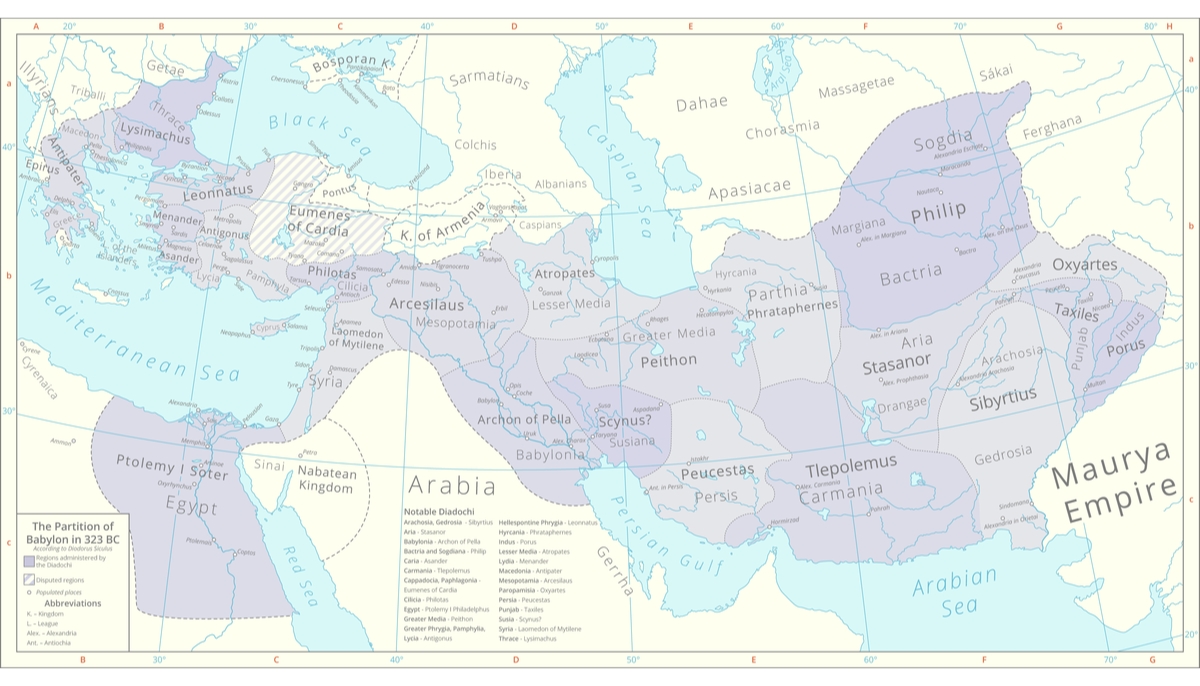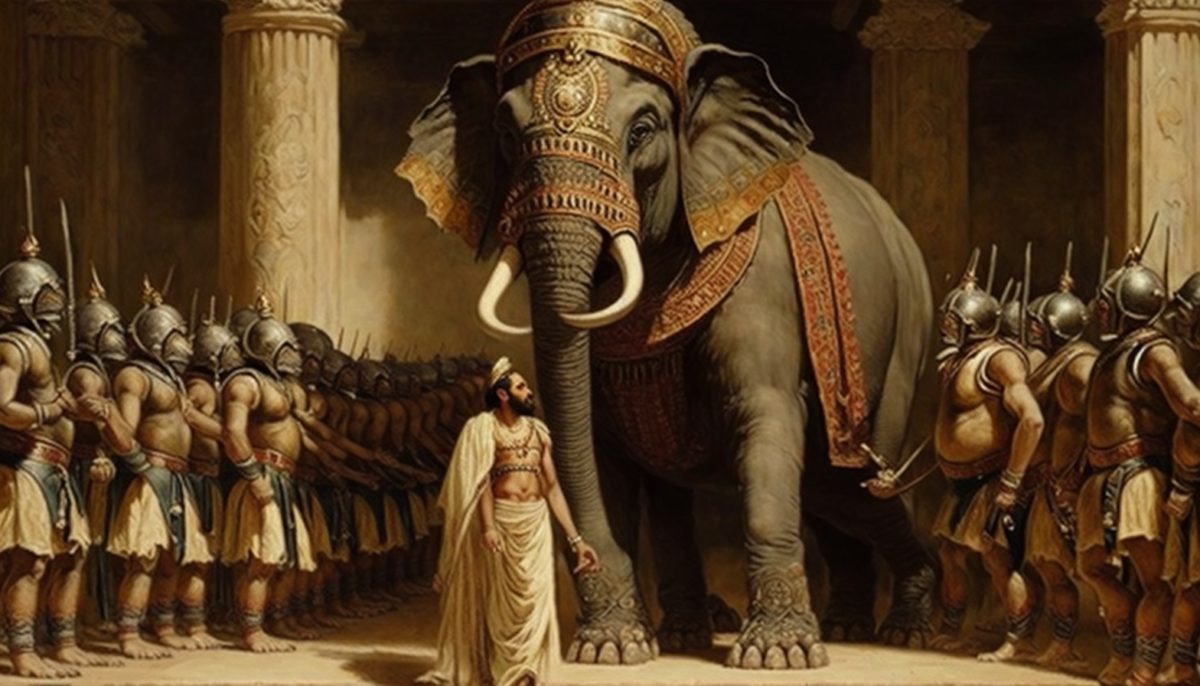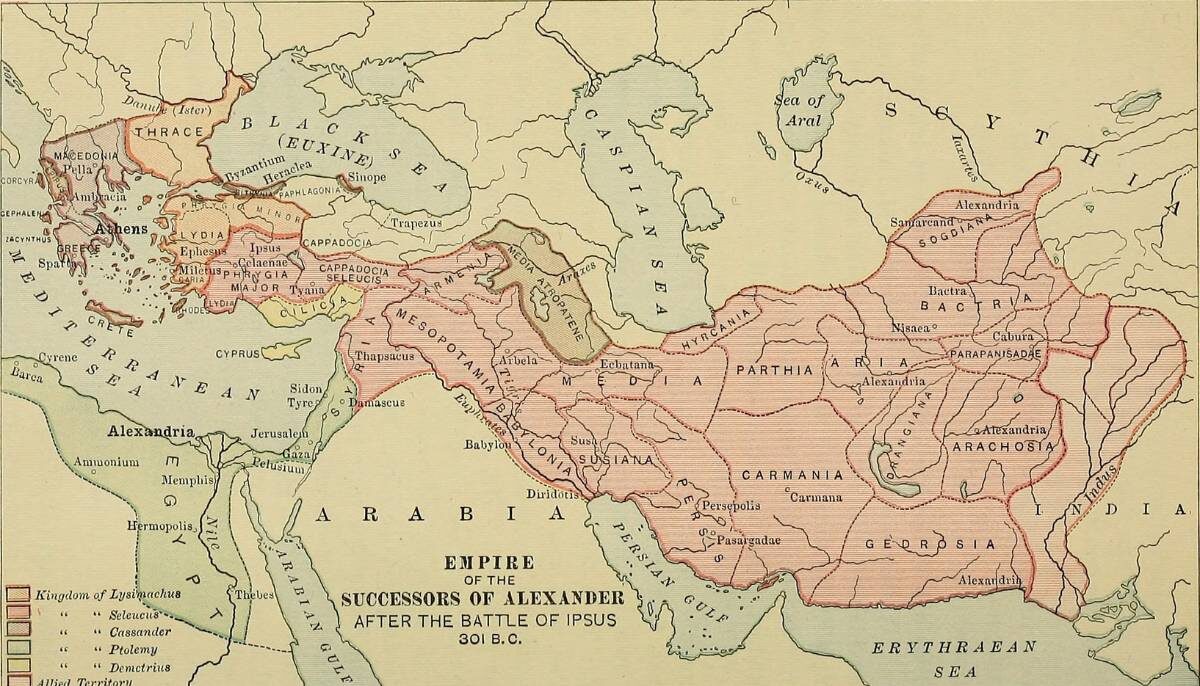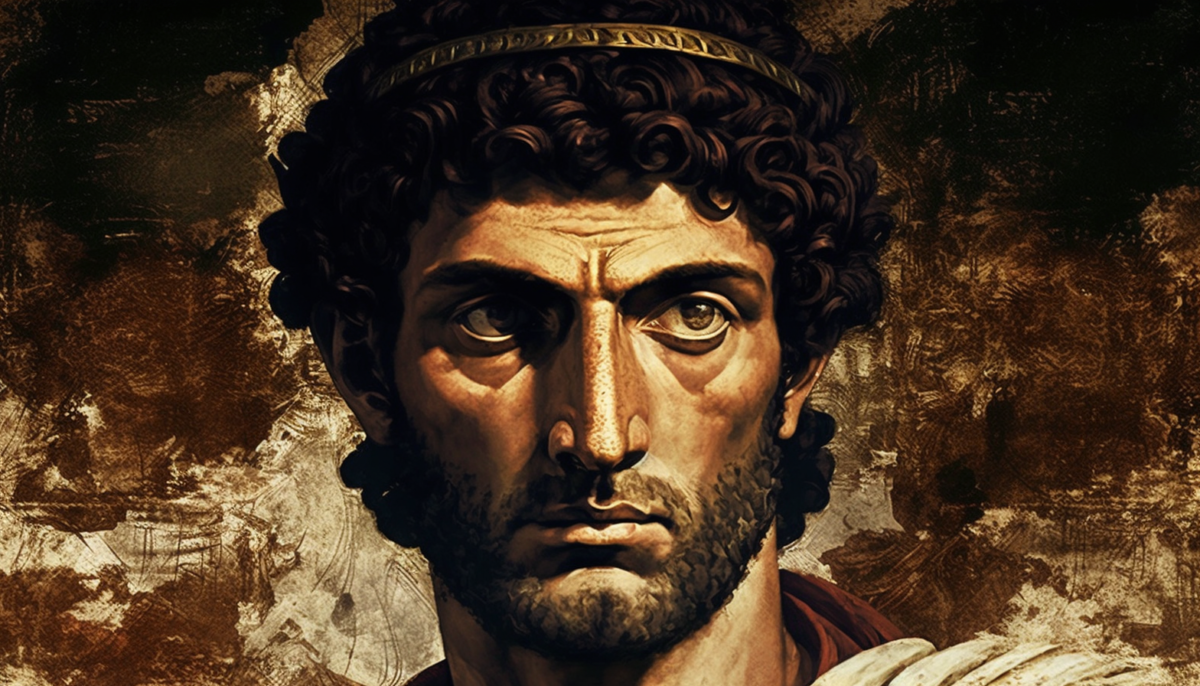Seleucus I Nicator was a prominent figure in the post-Alexander era of ancient history. Through military skill, political maneuvering, and sheer luck, he managed to carve out a large and prosperous empire in the Near East, centered around the fertile region of Mesopotamia.
In this article, we will examine Seleucus’s early life, his role in Alexander’s campaigns, and the series of wars and diplomatic efforts that enabled him to create the Seleucid Empire, one of the most enduring and influential states of the ancient world.
The early life of Seleucus and his role in Alexander the Great’s military
Seleucus Nicator was born in 358 BC in Orestis, a region of ancient Macedonia. He was a close companion and a Macedonian officer of Alexander the Great.
According to ancient sources, Seleucus was tall and physically strong, with a thick neck and a broad chest. He was also known for his bravery and military skills, demonstrated in many battles and campaigns alongside Alexander.
He started his career as a young soldier and quickly distinguished himself as a brave and skilled fighter, earning the respect and admiration of his fellow soldiers.
Seleucus and the Silver Shields

Seleucus rose through the ranks and eventually became the captain of the elite Silver Shields, a prestigious unit within the Macedonian army. This unit was known for its bravery and loyalty and played a crucial role in many of Alexander’s battles and conquests.
Unfortunately, few historical records detail Seleucus’ role in Alexander’s campaigns. However, it is clear that he was an essential figure in the Macedonian army and was highly respected by his fellow soldiers and commanders.
Life after the death of Alexander
When Alexander the Great died in Babylon in 323 BC, Seleucus Nicator was present. However, at that time, he was not among the high-ranking generals initially involved in dividing up Alexander’s vast empire.
Role of Seleucus under Perdiccas
Seleucus Nicator found a role under Perdiccas, who had become the regent of the empire and the most powerful man in the Greek world.
Seleucus was appointed to the critical position of head of the Companion cavalry, the elite fighting force that had played a key role in Alexander’s campaigns.
This was a significant honor for Seleucus, as the Companion cavalry was regarded as the Macedonian army’s most prestigious and respected unit.
Seleucus in the first war of the Diadochi (321–319 BC)

Seleucus followed Perdiccas to Egypt, hoping to assert his authority over Ptolemy, who had declared himself king of Egypt. However, Perdiccas’s campaign proved to be a disaster, and his troops eventually betrayed and killed him.
Seleucus likely masterminded the assassination of Perdiccas, executing a Machiavellian maneuver that dramatically elevated his status.
This was no small feat; it was the most cunning and pivotal political move of his life. Capitalizing on Perdiccas’s vulnerability after a disastrous Nile crossing attempt, Seleucus transitioned from a minor actor to a major powerhouse in the Hellenistic world.
Satrapy of Babylon

After the Treaty of Triparadisus in 321 BC, following the First Diadochi War, Seleucus secured the governance of Babylon.
Contrary to its rich cultural and economic landscape, the military capability of this eastern territory was notably weak. Antigonus, the current powerbroker, likely banked on this weakness, installing a puppet satrap to keep the region fragmented.
Seleucus consolidates power in the East.
Seleucus had a different vision. He swiftly ousted the existing satrap loyal to the defeated Perdiccas and gained the support of Babylon’s influential priesthood and elites.
His maneuvers were not without challenges, including competing claims from Docimus and internal strife in the empire. Yet, Seleucus successfully consolidated his rule, turning Babylon into a stronghold.
This transformation marked a pivotal moment in Seleucus’s trajectory, showcasing his knack for seizing political opportunities in key strategic areas.
And while the empire swirled in chaos—with assassinations, revolts, and wars—Seleucus remained focused on fortifying Babylon, thereby emerging as a potent player in the fractured post-Alexander world.
Seleucus and the Second War of the Diadochi (318–316 BC)
Seleucus Nicator’s role in the second Diadochi War was complex and challenging. While he was a skilled politician and ruler, he was not as strong militarily as other significant players in the conflict, such as Eumenes and Antigonus.
Seleucus had to play a careful and strategic political game to survive and thrive in this challenging environment. He was constantly maneuvering and negotiating with the other factions, seeking to build alliances and consolidate his power base wherever possible.
Alligeience with Antigonus
Ultimately, Seleucus found himself allied with Antigonus, one of the most powerful of the Diadochi. Together, they faced off against Eumenes, another of Alexander’s generals who had carved out a power base in the eastern regions of the empire.
In two key battles, Seleucus and Antigonus defeated Eumenes and his forces, culminating in his eventual capture and execution.
While Seleucus played a crucial role in these battles, it was ultimately Antigonus who emerged as the victor, consolidating his power over much of the eastern regions of the empire.
Fleeing Antigonus, partnership with Ptolemy

In the summer of 316 BC, Antigonus spent time in Babylon with Seleucus. However, their relationship quickly deteriorated due to a dispute over the punishment of an officer of Antigonus.
Seleucus, acting as the governor of Babylon, punished the officer for disobedience, which infuriated Antigonus and led to an argument between the two.
As tensions rose, Seleucus fled Babylon and sought refuge with Ptolemy I in Egypt. With only 50 horsemen, Seleucus escaped under the cover of darkness, leaving behind his possessions and his wives.
Seleucus and Ptolemy Alliance
Seleucus’s decision to flee was risky, leaving him vulnerable and without resources in a foreign land. However, he was confident in his ability to win over Ptolemy.
Ptolemy welcomed Seleucus with open arms, recognizing his potential as a valuable ally and strategist. With Ptolemy’s support, Seleucus rebuilt his forces and established himself as a critical player in the ongoing power struggles of the Diadochi.
The fallout between Antigonus and Seleucus was a significant turning point in Seleucus’s career, leading him to seek out new alliances and opportunities.
It also demonstrated his willingness to take risks and make bold moves to achieve his goals, which would serve him well.
Seleucus and the Third War of the Diadochi (315–311 BC)
The third Diadochi War was a critical moment in the power struggle between the Hellenistic kingdoms, and Seleucus played a significant role in the conflict. This time, he fought on the side of Ptolemy, serving as the admiral of his navy.
Seleucus’s primary contribution during the third war was rallying support for an anti-Antigonus coalition. Cassander of Macedon and Lysimachus of Thrace joined forces with Ptolemy and Seleucus, and together, they challenged Antigonus’s power in several key battles.
Naval victories
Seleucus’s early contributions to the war involved fighting Antigonus’s navy in the Aegean and eastern Mediterranean. He secured several victories and weakened Antigonus’s hold on the region.
Later, he participated in the Battle of Gaza, leading a force of a few thousand men. The battle was a turning point in the war, as Antigonus’s choice of Satrap Peithon of Babylon was killed, leaving an opening for Seleucus to return to Babylon.
With his return to Babylon, Seleucus had the opportunity to establish his power base and begin building his empire.
This moment is considered the traditional date of the founding of the Seleucid Empire, which would go on to become one of the most potent and influential Hellenistic states.
Return to Babylon, consolidation of the East.
After the Third Diadochi War, Seleucus faced the daunting task of consolidating his power in the East.
He knew that Antigonus, one of the most influential figures in the Hellenistic world, would not tolerate his ambitions for long. Therefore, Seleucus sought to build his strength and secure his position before Antigonus could launch an attack.
Expanding his territory
One of Seleucus’s first challenges was dealing with rival local satraps who challenged his authority. He successfully defeated two of them, Evagoras and Nicanor, in battle, eliminating potential threats to his rule.
Seleucus continued expanding his territory, conquering the province of Media, a vital economic and strategic region. This conquest further solidified his position and helped him build his strength.
Seleucus knew he could not rest on his laurels, as Antigonus remained a looming threat. He was determined to be prepared for any eventual attack and continued to build his military strength and alliances.
Babylonian War (311 BC)
After Seleucus had consolidated his power in the East, he faced the biggest challenge of his career – a war against Antigonus.
Seleucus had control over the eastern part of the former Alexandrian Empire, while Antigonus had made peace deals with Ptolemy, Lysimachus, and Cassander.
It was clear that a war between Seleucus and Antigonus was inevitable.
Unfortunately, we don’t have many sources that detail the course of the Babylonian War, but it is believed that Seleucus won a decisive battle against Antigonus.
After a full day of fighting that ended in a stalemate, Seleucus launched a daring morning attack that proved the critical difference. Antigonus was forced to retreat, and Seleucus emerged victorious.
War with the Maurya (306 BC)

After consolidating his power in the West, Seleucus turned his attention back to the East.
He fought several wars with the Maurya Emperor Chandragupta Maurya, including several over the Indus River. The battles were hard-fought and indecisive, with neither side gaining a clear advantage.
Eventually, Seleucus and Chandragupta reached a peace deal. As part of the agreement, Seleucus received 500 war elephants, which would prove critical in future wars in the West.
The elephants were a formidable battlefield weapon and helped Seleucus establish his dominance over his rivals.
Fourth war of the Diadochi (307–301 BC)
The Fourth War of the Diadochi was a pivotal moment in the history of the Hellenistic period. It was a conflict between two major factions: Seleucus, Cassander, Lysimachus, and Ptolemy on one side, and Antigonus and his son Demetrius on the other.
Seleucus played a crucial role in the war as one of the prominent leaders of the anti-Antigonus coalition.
Battle of Ipsus

The Battle of Ipsus, fought in 301 BC, was a decisive conflict in the Fourth War of the Diadochi.
Antigonus, who had been expanding his territory and influence, had put Cassander and Lysimachus on the ropes, but Seleucus, with his war elephants, launched an attack from the East.
The elephants caused havoc in Antigonus’ ranks and split his forces. Despite the bravery of Antigonus, he was ultimately killed in battle, and Demetrius was forced to flee.
Conflict with Ptolemy
After the Battle of Ipsus, Seleucus emerged as the dominant force in Syria, immediately putting him at odds with Ptolemy, who controlled Egypt and parts of the eastern Mediterranean.
To counter this, Seleucus allied with the recently defeated Demetrius, the son of Antigonus, and together, they dealt a severe blow to Ptolemy by destroying his fleet.
This prevented a direct conflict between Seleucus and Ptolemy and solidified Seleucus’ control over Syria and parts of Asia Minor.
However, the alliance between Seleucus and Demetrius did not last long, and they eventually became bitter enemies.
Victories over Demetrius and Lysimachus
Tensions soon arose between Seleucus and Demetrius over control of Cilicia. Demetrius’ troops were unhappy and not receiving their payments, which allowed Seleucus to bribe and persuade them to abandon Demetrius.
Seleucus eventually captured Demetrius, who died a few years later in captivity.
Lysimachus, another of Alexander’s successors, had become increasingly unpopular since the victory at Ipsus.
Seleucus saw an opportunity to weaken his power and went to war with him, defeating him at the Battle of Corupedium.
With Ptolemy I dying of old age, Seleucus emerged as the most powerful and last surviving of Alexander the Great’s contemporaries.
Death and Legacy of Seleucus I Nicator
Seleucus Nicator met his end in 281 BC, killed by Ptolemy Ceraunus, a son of Ptolemy I Soter. Ironically, this happened just as Seleucus prepared to claim Macedonia, a venture that could have further expanded his already vast empire.
His sudden and unexpected death marked the end of an era and curtailed what could have been an even more expansive realm.
In the tumultuous period following Alexander the Great’s death, Seleucus Nicator emerged as an unparalleled political strategist among the Diadochi.
Starting as a relatively minor player, he skillfully navigated the shifting alliances and conflicts that characterized this era. Seleucus had an uncanny ability to recognize the perfect moments for action, whether it was allying with Demetrius after defeating him, seeking refuge with Ptolemy when Antigonus posed a threat, or seizing opportunities to expand his domain.
His astute decision-making propelled him from the peripheries of power to becoming a central figure in the Hellenistic world.
Seleucid Empire
Following the death of the Seleucus Nicator in 281 BC, the Seleucid Empire continued to flourish for another 198 years.
A strong central government, a well-organized bureaucracy, and a large, diverse population characterized the empire. The Seleucids relied heavily on the support of their Greek and Hellenic subjects, who formed the bulk of the ruling class and provided a cultural and intellectual framework for the empire.
The Seleucids continued to expand their territory in the early years of the empire. Antiochus I Soter, who ruled from 281 to 261 BC, expanded the empire into eastern Iran and Central Asia while consolidating control over Anatolia and Syria.
The Seleucids were known for their patronage of Greek culture and learning. Many Greek intellectuals, artists, and philosophers were brought to the empire, where they were given positions of influence and respect.
The Seleucids also sponsored the construction of magnificent public works, such as temples, palaces, and theaters, serving as cultural and learning centers.
The decline and fall of the Seleucid empire
However, the Seleucids faced several challenges in the later years of the empire. The empire’s vast size and diverse population made it difficult to govern, and the Seleucids struggled to control their distant territories.
The empire also faced constant threats from neighboring powers, including the Parthians, the Armenians, and the Ptolemies of Egypt.
In the second century BC, the Seleucid Empire began to decline. The empire faced increasing pressure from the rising power of Rome, which had already conquered Greece and expanded into the eastern Mediterranean.
In 83 BC, the Roman general Pompey the Great invaded the Seleucid Empire, overthrowing the last Seleucid king and effectively ending the empire.
Despite its eventual decline, the Seleucid Empire was influential in spreading Greek culture and learning throughout the ancient world.
Many of the empire’s achievements in art, architecture, philosophy, and science continued to influence later civilizations for centuries.






